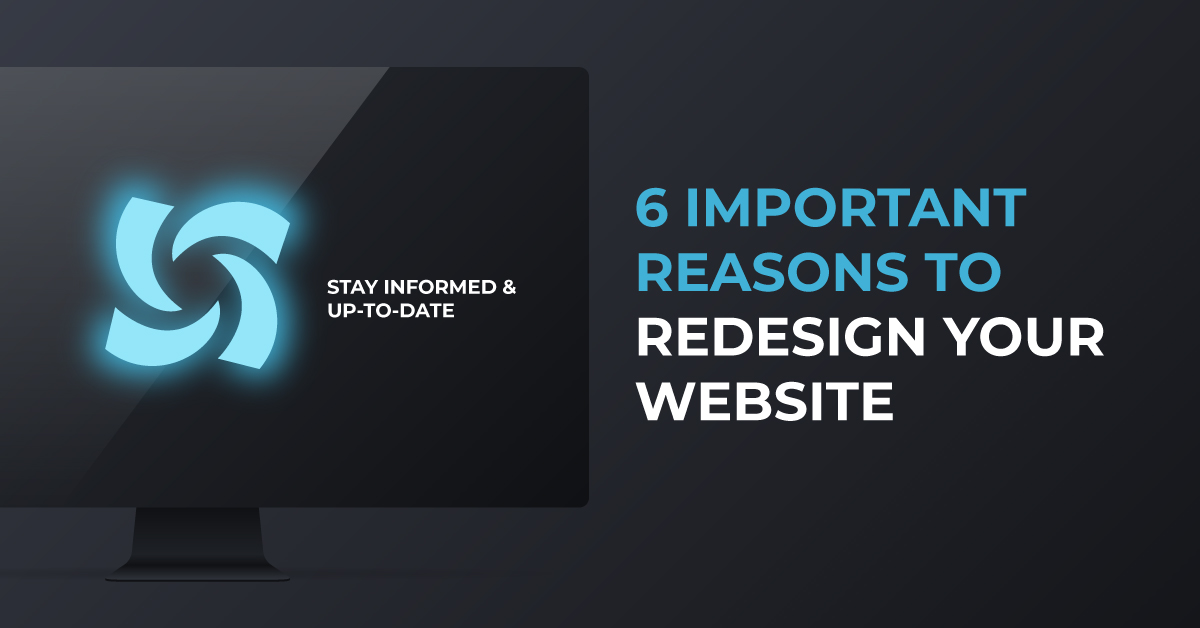The iPhone is on its 13th iteration. The iPod is officially discontinued. Newspapers haven’t been discontinued, but I didn’t see any on anyone’s front sidewalk on my way to work this morning. Odds are, if you were watching television last night, it was from a streaming service.
In 2022 we live in a world where technology is developing faster than most of us can keep up with. Additionally, websites and consumer behavior are being redeveloped and changing to fast, faster, fastest. We all know that a good website is one of the biggest keys to successful marketing these days, and to make sure your website is working as best as it can, you need constant web development.
Website redesign is not just about a new design. If your site is even a few years old, web technology has moved forward enough that you can make changes that offer a better user experience, easier management, and better functionality.
Here are six reasons to redesign your website.

1. Your Website Looks Outdated
It’s pretty easy for a website to become outdated. Unfortunately, design trends change yearly, and nothing ever stays on trend for very long. This isn’t to say that you must change your website every time a new fad takes over. If your site looks fresh and responsive and does its job for your company – it’s probably fine. But if it’s a website that nobody is paying attention to because of lack of knowledge, not enough time, or just plain negligence – you’d be surprised at how effective a refresh can be.
A dated website can make your entire company look out of touch – we’ve all been to websites that seem like they haven’t been refreshed for a decade, and the natural inclination is to click away and move on to somebody else.
Your website is probably outdated if: the homepage bounce rate is over 90% (even if it gets a small amount of traffic). The site was designed over two years ago and hasn’t been updated. Or, most tellingly, it doesn’t look like anything online (and not in an “ahead of the pack” way). It’s always a good idea to monitor your competitors, and if you feel like your website is falling behind, it’s time for a refresh.
Web hygiene recommends redesigning your site every 2-3 years. In that time, significant developments have happened in both technology and design.
2. Your Website is Not Mobile Responsive
Among our six reasons to redesign your website, we can argue which reason is the most important, but this one has as good an argument as any of them. In 2016, 52.4% of eCommerce was done on mobile phones. Currently, that number has jumped to 72.9%. Said another way, nearly three out of every four dollars spent on online purchases today is done through a mobile device. We have had smartphones for several years now, but only a few businesses have done a great job setting up their mobile presence. Over 50% of the world’s online traffic comes from mobile devices.
The increasing mobile trend will bring more and more mobile visitors to your site. That’s why offering them the same user experience as on desktop is essential. If your site does not leverage responsive design, it’s not mobile-friendly.
Websites that aren’t optimized for viewing on smartphones and tablets definitely need a refresh. A website that is not mobile responsive requires tedious screen pinching and zooming in and out for use. This inconvenience is more likely to drive customers away from your site, especially if your competitors have mobile-optimized websites.

Making your website mobile responsive is a crucial part of enhancing digital accessibility. A mobile responsive site updates the look and layout of the page depending on the device it is viewed on, providing users with an optimum experience no matter their device. So, whether you’re accessing sites on your tablet, smartphone, or tablet, you should have the ability to access every feature with the same ease.
For years, Google has been talking about mobile-first design. Recently it has begun rewarding mobile-first websites with higher rankings than those that aren’t. All mobile-first design means you design the site’s mobile version first and then the desktop site second. This enables a more minimal and streamlined experience for your web visitors.
The design elements you should consider as a fundamental reason to redesign your website include:
- Eliminating horizontal scrolling
- Increased font size and reduced image size
- Creating ample space for tap targets
- Minimal data required for loading
A good sign your website needs a redesign is if it is getting a good number of mobile visitors, but the mobile performance is much worse than the desktop version.

3. Visitors are Having a Difficult Time Using Your Website
A website that appears old and unmaintained is a significant problem that just about anyone can see. Less obvious is a pretty website that is just too difficult to use.
When you’re thinking about redesigning your website, your first step should be to determine what’s wrong with it. There are several ways in which visitors may have a hard time using your site – the navigation might be too cluttered and convoluted, and the user journey is confusing. It leads to dead ends; the copy isn’t concise and formatted for easy readability, and even too many CTAs can make for a challenging experience. Consider conversion rates, time spent on site, bounce rate, and cart abandonment.
So how do you gauge if your website is difficult to use and you have reason to redesign it? There are usually signs that will let you know, and three of the major ones are:
- Your average time-on-page time is either really short (10 seconds or less), or it’s too long and comes with high bounce rates
- You get a solid amount of daily traffic but lag in generating leads or conversions
- Google Analytics reveals that both user and behavior flow show that most users aren’t following the journey or path that you laid out for them
Figure out why you’re not getting the results you want. Do you have a lot of customers leaving at the checkout stage? If so, it might be a problem with your payment options. If customers leave your landing page as soon as they reach it, you probably have a more significant design problem. Redesigning your website allows you to find these pain points and improve them.

4. Your Navigation is Unclear
Users don’t like getting lost on a website. It should be apparent to first-time users exactly where they need to go to see what they want. If users get frustrated for even a moment, they’ll bail on your site faster than you can say, “but we have great products.”
Assess the navigation on your site, and if you’re not positive that it makes complete sense, that’s an important reason to redesign your website.
A sensible, well-structured navigation feature lets users move seamlessly from one part of the site to another. An estimated 76% of users say that a website’s most crucial element is making it easy for them to find things. Read that sentence again and honestly assess if you need a redesign or not. Slow loading and unresponsiveness are the only traits that rank higher as reasons to leave a website. Site navigation should be straightforward and organic. One way to improve your navigation is to de-clutter the main menu. Too many choices can confuse users and affect your page’s UI from a design perspective. Limiting your options to a maximum of five or six makes it much easier to find and click through to the things users want to access.

5. Marketing and Sales Strategies Need to Change
Does your website have obvious sales and marketing features? If not, you probably need to redesign it; rest assured that’s perhaps your competitor’s favorite part about your site.
Websites don’t exist just to put a digital face to a brand. They can also be potent sales and marketing tools when they’re set up that way. At this point, the homepage of your website is your single most important advertisement.
The first thing to figure out is what type of marketing or sales strategy is missing: SEO, content marketing (blogs), social media integration, or sales funnels.
If you don’t have any of those, it’s probably wise to start with SEO, as that’s the most important in the group. Don’t just look at how you will add or enhance the sales and marketing features. Consider how their existence will affect things like the navigation structure and homepage content. If your company has pivoted in what your products and services are, your website should reflect and advocate that change – you don’t want to attract the wrong type of clients to your site. Studies show that 75% of consumers judge a company’s credibility based on its website design.

6. Measuring Effectiveness
To state the obvious, if your website is working, you might not need a site redesign. So how do you check if your site working? Or if it’s working as well as it could be? You need to have a way to measure your website’s effectiveness. If you find room for improvement, that is an important reason to redesign your website.
Good website data makes for a simple action plan for your sales team, and the wealth of insight you can get from your website analytics is limitless. An old website probably isn’t equipped to help you measure how effective your online presence is. Your website should be a huge asset for your business. Your digital presence has a significant impact on turning page views into customers. If you don’t think your website is quite the asset that it should be, that’s an important reason to redesign your website.







